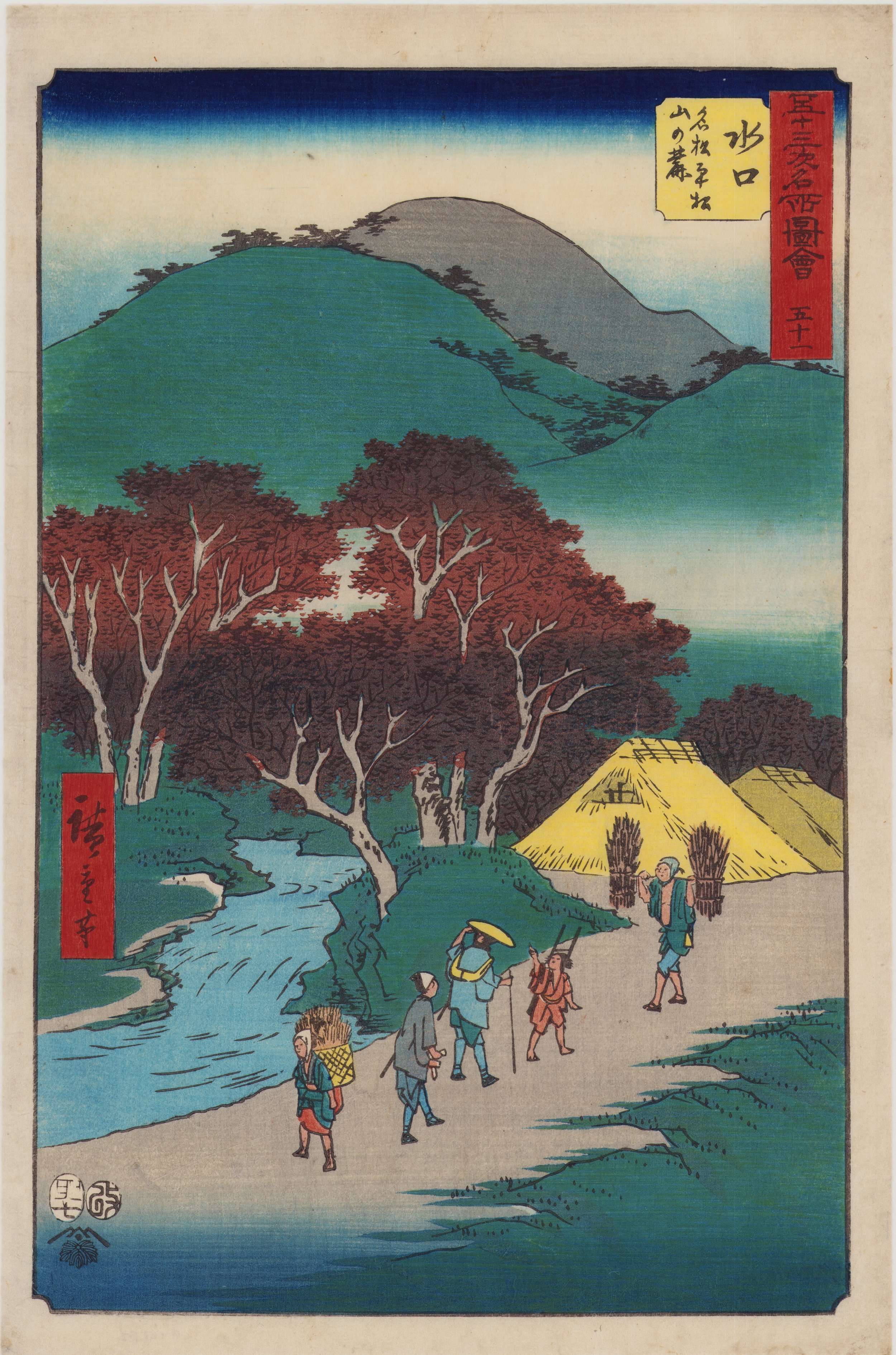Hiroshige | Mizukuchi, Upright Tokaido
歌川広重 Utagawa Hiroshige (1797-1858)
五十三次名所图绘 水口
Mizukuchi, from the series of Pictures of Famous Places of the 53 Stations
1855
木版画 | 纵绘大判 | 36cm x 25cm
Woodblock-print | Oban tate-e | 36cm x 25cm
早期版次;品相非常好
Early impression; very good condition
SOLD
《五十三次名所图会》,是广重在1855年创作的,一套以东海道五十三次为题材的风景版画。在此系列中,广重一改往日的横绘,首次使用了纵向构图的竖绘。通常而言,纵向构图的风景画能强化垂直景物的存在感,并通过明显的画面纵深,表现出景别由近及远的节奏感,增强观赏者对画面的场景体验,有着横向构图难以达到的独特张力。水口宿,东海道五十三次中的第50处宿场,位于今滋贺县甲贺市水口町境内。在其与临近的石部宿之间的平松地区,生长着一种当地独有的赤松变种——美松。由于隐性基因的作用,它们的树干从基部附近就呈放射状分枝,并向上延伸生长,仿佛是被细心修剪过的园林树一般格外美观,自古以来就广为人们喜爱,早在1921年就被指定为国家天然纪念物。“您瞧那边的松树,它们多美呀!”层峦耸翠外,乡间小路上,一位身着橘色布衣的孩子手指美松,对着后方持杖赶路的旅人说道。旅人稍抬笠檐,望向不远处蓬勃生长,枝叶茂盛的丛丛美松,也不由得停住了脚步。对向而行的两位荷薪樵夫却早已惯看溪流松风,只顾一路前行。美松无言,观者无语,刹那间的相会,在画中成为永恒。
Interested in purchasing?
Please contact us.
歌川広重 Utagawa Hiroshige (1797-1858)
五十三次名所图绘 水口
Mizukuchi, from the series of Pictures of Famous Places of the 53 Stations
1855
木版画 | 纵绘大判 | 36cm x 25cm
Woodblock-print | Oban tate-e | 36cm x 25cm
早期版次;品相非常好
Early impression; very good condition
SOLD
《五十三次名所图会》,是广重在1855年创作的,一套以东海道五十三次为题材的风景版画。在此系列中,广重一改往日的横绘,首次使用了纵向构图的竖绘。通常而言,纵向构图的风景画能强化垂直景物的存在感,并通过明显的画面纵深,表现出景别由近及远的节奏感,增强观赏者对画面的场景体验,有着横向构图难以达到的独特张力。水口宿,东海道五十三次中的第50处宿场,位于今滋贺县甲贺市水口町境内。在其与临近的石部宿之间的平松地区,生长着一种当地独有的赤松变种——美松。由于隐性基因的作用,它们的树干从基部附近就呈放射状分枝,并向上延伸生长,仿佛是被细心修剪过的园林树一般格外美观,自古以来就广为人们喜爱,早在1921年就被指定为国家天然纪念物。“您瞧那边的松树,它们多美呀!”层峦耸翠外,乡间小路上,一位身着橘色布衣的孩子手指美松,对着后方持杖赶路的旅人说道。旅人稍抬笠檐,望向不远处蓬勃生长,枝叶茂盛的丛丛美松,也不由得停住了脚步。对向而行的两位荷薪樵夫却早已惯看溪流松风,只顾一路前行。美松无言,观者无语,刹那间的相会,在画中成为永恒。
Interested in purchasing?
Please contact us.
歌川広重 Utagawa Hiroshige (1797-1858)
五十三次名所图绘 水口
Mizukuchi, from the series of Pictures of Famous Places of the 53 Stations
1855
木版画 | 纵绘大判 | 36cm x 25cm
Woodblock-print | Oban tate-e | 36cm x 25cm
早期版次;品相非常好
Early impression; very good condition
SOLD
《五十三次名所图会》,是广重在1855年创作的,一套以东海道五十三次为题材的风景版画。在此系列中,广重一改往日的横绘,首次使用了纵向构图的竖绘。通常而言,纵向构图的风景画能强化垂直景物的存在感,并通过明显的画面纵深,表现出景别由近及远的节奏感,增强观赏者对画面的场景体验,有着横向构图难以达到的独特张力。水口宿,东海道五十三次中的第50处宿场,位于今滋贺县甲贺市水口町境内。在其与临近的石部宿之间的平松地区,生长着一种当地独有的赤松变种——美松。由于隐性基因的作用,它们的树干从基部附近就呈放射状分枝,并向上延伸生长,仿佛是被细心修剪过的园林树一般格外美观,自古以来就广为人们喜爱,早在1921年就被指定为国家天然纪念物。“您瞧那边的松树,它们多美呀!”层峦耸翠外,乡间小路上,一位身着橘色布衣的孩子手指美松,对着后方持杖赶路的旅人说道。旅人稍抬笠檐,望向不远处蓬勃生长,枝叶茂盛的丛丛美松,也不由得停住了脚步。对向而行的两位荷薪樵夫却早已惯看溪流松风,只顾一路前行。美松无言,观者无语,刹那间的相会,在画中成为永恒。
Interested in purchasing?
Please contact us.
Utagawa Hiroshige (1797-1858)
Ando Hiroshige (1897-1858) revolutionized the art of landscape prints during the Edo era, building on the success of his senior, Hokusai, but taking a more poetic and naturalist approach to portraying the beauty of Japan.
The son of a low-level Samurai assigned to the fire brigade in Edo, Hiroshige became a student of the Utagawa school as a young man. His first prints focused on beautiful women (bijin), and views of Edo. But in 1833 he began work on his most famous early work, his first series depicting the Tokaido, the "Great Sea Road" between Edo and Tokyo.
Today there is some controversy about this series. Initially, it was believed that Hiroshige had travelled the route along with a local lord (Daimyo) who was making a gift of horses to the Emperor. But more recent scholarship suggests Hiroshige never travelled the road himself, at least not the entire way, and made his designs using published guidebooks.
Nonetheless, the prints were wonderful and revolutionary. They embraced the seasons with a gentle lyricism missing from Hokusai's striking but stylized depictions. In Hiroshige's work, nature is sacred -- but it is always mixed with humanity, with travelers or little inns or bridges. There is a magical harmony between man and the elements.
His depiction of the seasons and weather is especially evocative. Snow blankets some views with a hushed silence, while rain streaks down furiously in others. In some prints natured is agitated; in others, calm prevails. Produced in a horizontal oban yoko-e format, the series was a smash hit.
The Tokaido series made Hiroshige famous, and he became incredible prolific. In the 1840s he produced many strong designs, but many mediocre ones, too, including several subsequent Tokaido series of varying quality.
In 1853, however, he made a big step. He turned his landscapes sideways, embracing a bold vertical oban tate-e format. This gave his designs new energy and a modern feel. The first of these was Famous Views of the Sixty-Odd Provinces. From them on, most of his most noted series were executed in this format.
He saved his greatest for his last. In 1856 he began work on 100 Famous Views of Edo, which many consider his most exceptional work. Here his home city was portrayed with energy and passion, and in these 119 designs he created an incredible record of a vanished place. In addition to the striking vertical format, he developed exciting new compositions, often juxtaposing a strong foreground element with a distant background.
Among the many famous images in this series are Squall at Ohashi and the Plum Garden in Komeido. Both of these were copied by Vincent Van Gogh, a great admirer of Hiroshige. Thus, the great Japanese artist had a profound effect on Western art.
Alas, his beloved Edo ended his life. Hiroshige was claimed by a cholera epidemic that swept the city in 1958. His pupil Shigenobu, who took the name Hiroshige II, completed The Famous Views of Edo.


